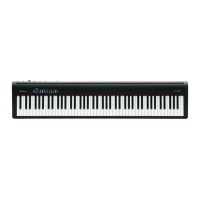MIDI Implementation
24
70123: Stereo Flanger
This is a stereo anger. (The LFO has the same phase for left and right.)
It produces a metallic resonance that rises and falls like a jet airplane taking o or
landing. A lter is provided so that you can adjust the timbre of the anged sound.
No Parameter Value Description
1 Filter Type 0–2 O, Lpf, Hpf
Type of lter
O: No lter is used
Lpf: Cuts the frequency range
above the Cuto Freq
Hpf: Cuts the frequency range
below the Cuto Freq
2 Cuto Freq 0–16 200–8000 Hz Basic frequency of the lter
3 Pre Delay 0–125 0.0–100.0 ms
Adjusts the delay time from
when the direct sound begins
until the anger sound is
heard.
4 Rate Mode 0–1 Hz, note
When this is set to “note,” the
eect is synchronized with
the tempo.
5 Rate #1 1–127
0.05–10.00
Hz
Frequency of modulation (Hz)
6 Rate 0–21 note
Frequency of modulation
(note)
7 Depth #2 0–127 0–127 Depth of modulation
8 Phase 0–90 0–180 deg Spatial spread of the sound
9 Feedback 0–98 -98–+98 %
Adjusts the proportion of the
anger sound that is fed back
into the eect. Negative (-)
settings will invert the phase.
10 Low Gain 0–30 -15–+15 dB Gain of the low range
11 High Gain 0–30 -15–+15 dB Gain of the high range
12 Balance 0–100
D100:0W–
D0:100W
Volume balance between the
direct sound (D) and the
anger sound (W)
13 Level 0–127 0–127 Output Level
70127: 3D Flanger
This applies a 3D eect to the anger sound. The anger sound will be positioned
90 degrees left and 90 degrees right.
No Parameter Value Description
1 Filter Type 0–2 O, Lpf, Hpf
Type of lter
O: No lter is used
Lpf: Cuts the frequency range
above the Cuto Freq
Hpf: Cuts the frequency range
below the Cuto Freq
2 Cuto Freq 0–16 200–8000 Hz Basic frequency of the lter
3 Pre Delay 0–125 0.0–100.0 ms
Adjusts the delay time from
when the direct sound begins
until the anger sound is
heard.
4 Rate Mode 0–1 Hz, note
When this is set to “note,” the
eect is synchronized with
the tempo.
5 Rate #1 1–127
0.05–10.00
Hz
Frequency of modulation (Hz)
6 Rate 0–21 note
Frequency of modulation
(note)
7 Depth #2 0–127 0–127 Depth of modulation
8 Phase 0–90 0–180 deg Spatial spread of the sound
9 Feedback 0–98 -98–+98 %
Adjusts the proportion of the
anger sound that is fed back
into the eect. Negative (-)
settings will invert the phase.
No Parameter Value Description
10 Output Mode 0–1
Speaker,
Phones
Adjusts the method that will
be used to hear the sound
that is output to the Output
jacks. The optimal 3D eect
will be achieved if you select
Speaker when using speakers,
or Phones when using
headphones.
11 Low Gain 0–30 -15–+15 dB Gain of the low range
12 High Gain 0–30 -15–+15 dB Gain of the high range
13 Balance 0–100
D100:0W–
D0:100W
Volume balance between the
direct sound (D) and the
anger sound (W)
14 Level 0 –127 0 –127 Output Level
70128: 2Band Flanger
A anger that lets you apply an eect independently to the low-frequency and
high-frequency ranges.
No Parameter Value Description
1 Split Freq 0–16 200–8000 Hz
Frequency at which the low
and high ranges will be
divided
2
Low Pre
Delay
0–125 0.0–100.0 ms
Delay time from when the
original sound is heard to
when the low-range anger
sound is heard
3
Low Rate
Mode
0–1 Hz, note
When this is set to “note,” the
eect is synchronized with
the tempo.
4 Low Rate #1 1–127
0.05–10.00
Hz
Rate at which the low-range
anger sound is modulated
(Hz)
5 Low Rate 0–21 note
Rate at which the low-range
anger sound is modulated
(note)
6 Low Depth 0 –127 0–127
Modulation depth for the low-
range anger sound
7 Low Phase 0–90 0–180 deg
Spaciousness of the
low-range anger sound
8
Low
Feedback
0–98 -98–+98 %
Proportion of the low-range
anger sound that is to be
returned to the input
(negative values invert the
phase)
9
High Pre
Delay
0–125 0.0–100.0 ms
Delay time from when the
original sound is heard to
when the high-range anger
sound is heard
10
High Rate
Mode
0–1 Hz, note
When this is set to “note,” the
eect is synchronized with
the tempo.
11 High Rate #2 1–127
0.05–10.00
Hz
Rate at which the high-range
anger sound is modulated
(Hz)
12 High Rate 0–21 note
Rate at which the high-range
anger sound is modulated
(note)
13 High Depth 0–127 0 –127
Modulation depth for the
high-range anger sound
14 High Phase 0–90 0–180 deg
Spaciousness of the
high-range anger sound
15
High
Feedback
0–98 -98–+98 %
Proportion of the high-range
anger sound that is to be
returned to the input
(negative values invert the
phase)
16 Balance 0–100
D100:0W–
D0:100W
Volume balance of the
original sound (D) and anger
sound (W)
17 Level 0–127 0 –127 Output volume

